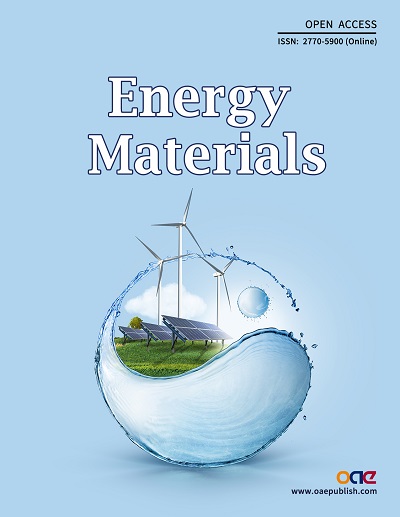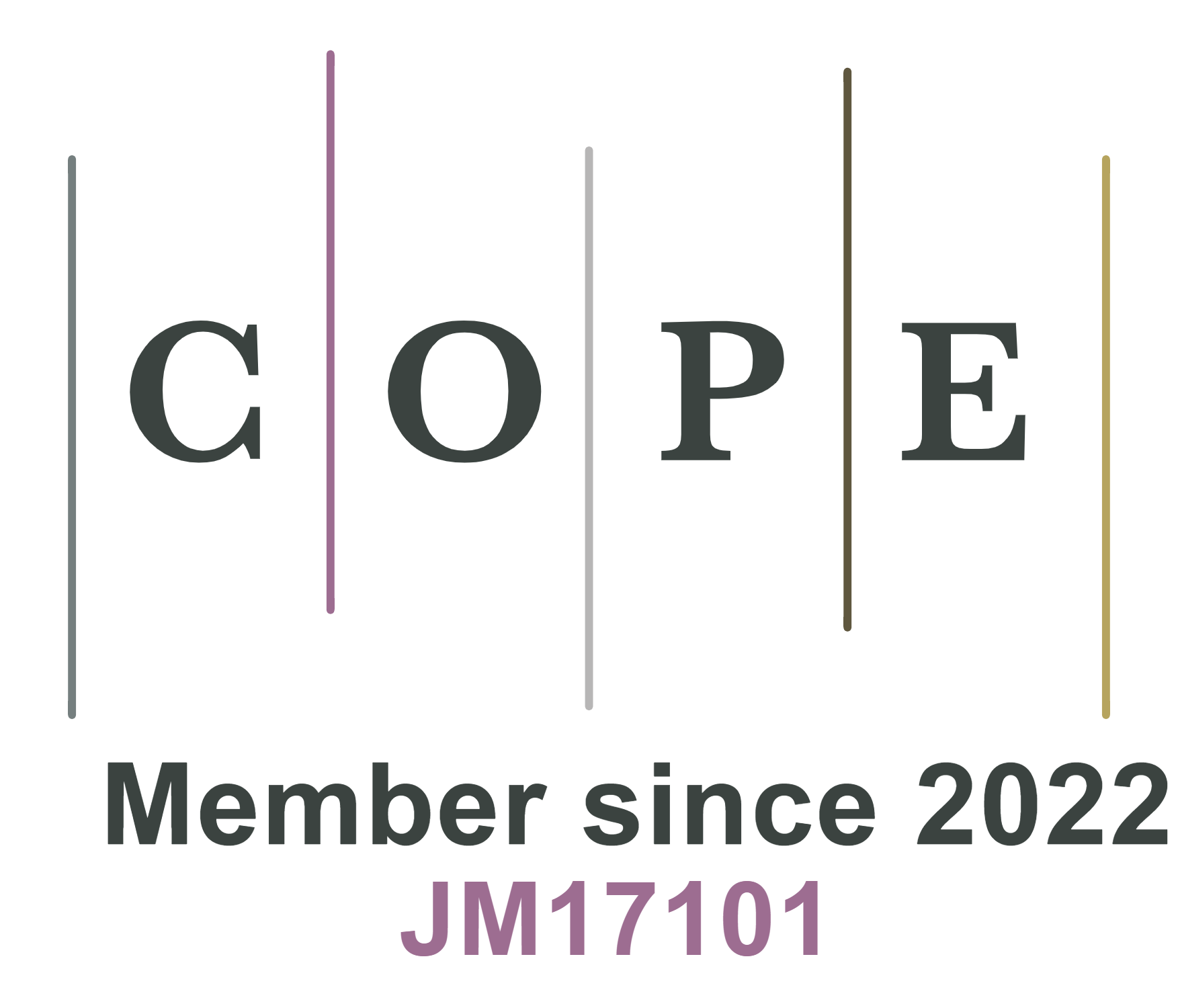REFERENCES
2. Pomerantseva E, Bonaccorso F, Feng X, Cui Y, Gogotsi Y. Energy storage: the future enabled by nanomaterials. Science 2019;366:eaan8285.
3. Xiao Y, Xu R, Xu L, Ding J, Huang J. Recent advances in anion-derived SEIs for fast-charging and stable lithium batteries. Energy Mater 2022;1:100013.
4. Chen D, Lu R, Yu R, et al. Work-function-induced interfacial built-in electric fields in Os-OsSe2 Heterostructures for Active Acidic and Alkaline Hydrogen Evolution. Angew Chem Int Ed 2022;61:e202208642.
5. Deng J, Ren P, Deng D, Bao X. Enhanced electron penetration through an ultrathin graphene layer for highly efficient catalysis of the hydrogen evolution reaction. Angew Chem Int Ed 2015;54:2100-4.
6. Zhu J, Guo Y, Liu F, et al. Regulative electronic states around ruthenium/ruthenium disulphide heterointerfaces for efficient water splitting in acidic media. Angew Chem Int Ed 2021;60:12328-34.
7. Pan F, Jin T, Yang W, et al. Theory-guided design of atomic Fe-Ni dual sites in N,P-co-doped C for boosting oxygen evolution reaction. Chem Catal 2021;1:734-45.
8. Liu S, Li C, Zachman MJ, et al. Atomically dispersed iron sites with a nitrogen-carbon coating as highly active and durable oxygen reduction catalysts for fuel cells. Nat Energy 2022;7:652-63.
9. Wang X, Fu N, Liu JC, et al. Atomic replacement of PtNi nanoalloys within Zn-ZIF-8 for the fabrication of a multisite CO2 reduction electrocatalyst. J Am Chem Soc 2022;144:23223-9.
10. Xue D, Xia H, Yan W, Zhang J, Mu S. Defect engineering on carbon-based catalysts for electrocatalytic CO2 reduction. Nanomicro Lett 2020;13:5.
11. Zhang Y, Gao P, Jiao F, et al. Chemistry of ketene transformation to gasoline catalyzed by H-SAPO-11. J Am Chem Soc 2022;144:18251-8.
12. Garrido-Barros P, Derosa J, Chalkley MJ, Peters JC. Tandem electrocatalytic N2 fixation via proton-coupled electron transfer. Nature 2022;609:71-6.
13. Li Z, Deng Z, Ouyang L, et al. CeO2 nanoparticles with oxygen vacancies decorated N-doped carbon nanorods: a highly efficient catalyst for nitrate electroreduction to ammonia. Nano Res 2022;15:8914-21.
14. Xia H, Zan L, Wei Y, et al. Catalytic effect of carbon-based electrode materials in energy storage devices. Sci China Mater 2022;65:3229-42.
15. Qing G, Ghazfar R, Jackowski ST, et al. Recent advances and challenges of electrocatalytic N2 reduction to ammonia. Chem Rev 2020;120:5437-516.
16. Zhou L, Chen L, Ding Z, et al. Enhancement of interfacial catalysis in a triphase reactor using oxygen nanocarriers. Nano Res 2021;14:172-6.
17. Liu M, Lei Z, Ke Q, et al. Regulation of hydrogen evolution performance of titanium oxide-carbon composites at high current density with a Ti-O hybrid orbital. Carbon Energy 2022;4:480-90.
18. Chen X, Qiao Z, Hou B, et al. Chiral metal-organic frameworks with tunable catalytic selectivity in asymmetric transfer hydrogenation reactions. Nano Res 2021;14:466-72.
19. Zhang X, Zhu X, Bo S, et al. Identifying and tailoring C-N coupling site for efficient urea synthesis over diatomic Fe-Ni catalyst. Nat Commun 2022;13:5337.
20. Wan X, Shui J. Exploring durable single-atom catalysts for proton exchange membrane fuel cells. ACS Energy Lett 2022;7:1696-705.
21. Hu J, Xu Q, Wang X, et al. Charge-transfer-regulated bimetal ferrocene-based organic frameworks for promoting electrocatalytic oxygen evolution. Carbon Energy 2023;5:e315.
22. Guo Y, Wang M, Zhu Q, Xiao D, Ma D. Ensemble effect for single-atom, small cluster and nanoparticle catalysts. Nat Catal 2022;5:766-76.
23. Cheng N, Stambula S, Wang D, et al. Platinum single-atom and cluster catalysis of the hydrogen evolution reaction. Nat Commun 2016;7:13638.
24. Kim J, Yoo JM, Lee HS, Sung Y, Hyeon T. Single-atom M-N-C catalysts for oxygen reduction electrocatalysis. Trends Chem 2021;3:779-94.
25. Tang X, Wei Y, Zhai W, et al. Carbon nanocage with maximum utilization of atomically dispersed iron as efficient oxygen electroreduction nanoreactor. Adv Mater 2023;35:e2208942.
26. Song LN, Zhang W, Wang Y, et al. Tuning lithium-peroxide formation and decomposition routes with single-atom catalysts for lithium-oxygen batteries. Nat Commun 2020;11:2191.
27. Han L, Cheng H, Liu W, et al. A single-atom library for guided monometallic and concentration-complex multimetallic designs. Nat Mater 2022;21:681-8.
28. Xia H, Qu G, Yin H, Zhang J. Atomically dispersed metal active centers as a chemically tunable platform for energy storage devices. J Mater Chem A 2020;8:15358-72.
29. Tian Z, Zhang Y, Zhu J, Li Q, Liu T, Antonietti M. A reanalysis of the diverse sodium species in carbon anodes for sodium ion batteries: a thermodynamic view. Adv Energy Mater 2021;11:2102489.
30. Kumar K, Asset T, Li X, et al. Fe-N-C electrocatalysts’ durability: effects of single atoms’ mobility and clustering. ACS Catal 2021;11:484-94.
31. Patniboon T, Hansen HA. Acid-stable and active M-N-C catalysts for the oxygen reduction reaction: the role of local structure. ACS Catal 2021;11:13102-18.
32. Rojas-carbonell S, Artyushkova K, Serov A, Santoro C, Matanovic I, Atanassov P. Effect of pH on the activity of platinum group metal-free catalysts in oxygen reduction reaction. ACS Catal 2018;8:3041-53.
33. Wu Z, Shen J, Li C, et al. Mo2TiC2 MXene-supported Ru clusters for efficient photothermal reverse water-gas shift. ACS Nano 2022;17:1550-9.
34. Wang Y, Guo T, Tian Z, Bibi K, Zhang YZ, Alshareef HN. MXenes for energy harvesting. Adv Mater 2022;34:e2108560.
35. Liu H, Jiang L, Khan J, et al. Decorating single-atomic mn sites with FeMn clusters to boost oxygen reduction reaction. Angew Chem Int Ed 2023;62:e202214988.
36. Ye C, Zheng M, Li Z, et al. Electrical pulse induced one-step formation of atomically dispersed Pt on oxide clusters for ultra-low-temperature zinc-air battery. Angew Chem Int Ed 2022;61:e202213366.
37. Yang L, Li G, Ma R, et al. Nanocluster PtNiP supported on graphene as an efficient electrocatalyst for methanol oxidation reaction. Nano Res 2021;14:2853-60.
38. Yin H, Xia H, Zhao S, Li K, Zhang J, Mu S. Atomic level dispersed metal-nitrogen-carbon catalyst toward oxygen reduction reaction: synthesis strategies and chemical environmental regulation. Energy Environ Mater 2021;4:5-18.
39. Zhao S, Yin H, Xia H, et al. The assembling principle and strategies of high-density atomically dispersed catalysts. Chem Eng J 2021;417:127917.
40. Wu Z, Zhao Y, Xiao W, et al. Metallic-bonded Pt-Co for atomically dispersed Pt in the Co4N Matrix as an efficient electrocatalyst for hydrogen generation. ACS Nano 2022;16:18038-47.
41. Yang Y, Yang Q, Yang Y, et al. Enhancing water oxidation of Ru single atoms via oxygen-coordination bonding with NiFe layered double hydroxide. ACS Catal 2023;13:2771-9.
42. Chen J, Huang B, Cao R, et al. Steering local electronic configuration of Fe-N-C-based coupling catalysts via ligand engineering for efficient oxygen electroreduction. Adv Funct Mater 2023;33:2209315.
43. Ou H, Li G, Ren W, et al. Atomically dispersed Au-assisted C-C coupling on red phosphorus for CO2 photoreduction to C2H6. J Am Chem Soc 2022;144:22075-82.
44. Liu F, Xia Y, Xu W, et al. Integration of bimetallic electronic synergy with oxide site isolation improves the selective hydrogenation of acetylene. Angew Chem Int Ed 2021;60:19324-30.
45. Guo Y, Yuan P, Zhang J, et al. Co2P-CoN double active centers confined in N-doped carbon nanotube: heterostructural engineering for trifunctional catalysis toward HER, ORR, OER, and Zn-air batteries driven water splitting. Adv Funct Mater 2018;28:1805641.
46. Sun Q, Chen BWJ, Wang N, et al. Zeolite-encaged Pd-Mn nanocatalysts for CO2 hydrogenation and formic acid dehydrogenation. Angew Chem Int Ed 2020;59:20183-91.
47. Liang D, Wang Y, Chen M, et al. Dry reforming of methane for syngas production over attapulgite-derived MFI zeolite encapsulated bimetallic Ni-Co catalysts. Appl Catal B Environ 2023;322:122088.
48. Fang JY, Zheng QZ, Lou YY, et al. Ampere-level current density ammonia electrochemical synthesis using CuCo nanosheets simulating nitrite reductase bifunctional nature. Nat Commun 2022;13:7899.
49. Aitbekova A, Zhou C, Stone ML, et al. Templated encapsulation of platinum-based catalysts promotes high-temperature stability to 1,100 °C. Nat Mater 2022;21:1290-7.
50. Chi X, Li M, Di J, et al. A highly stable and flexible zeolite electrolyte solid-state Li-air battery. Nature 2021;592:551-7.
51. Zhao H, Yu R, Ma S, et al. The role of Cu1-O3 species in single-atom Cu/ZrO2 catalyst for CO2 hydrogenation. Nat Catal 2022;5:818-31.
52. Yuan C, Zeng P, Cheng C, et al. Boosting the rate performance of Li-S batteries via highly dispersed cobalt nanoparticles embedded into nitrogen-doped hierarchical porous carbon. CCS Chem 2022;4:2829-41.
53. Zhao Y, Pei Z, Lu XF, Luan D, Wang X, Lou XW. Rationally designed nitrogen-doped carbon macroporous fibers with loading of single cobalt sites for efficient aqueous Zn-CO2 batteries. Chem Catal 2022;2:1480-93.
54. Su Y, Hao J, Liu X, Yang Y. Progress of atomic layer deposition and molecular layer deposition in the development of all-solid-state lithium batteries. Batteries Supercaps 2023;6:e202200359.
55. Wen Z, Zhang S, Liu Z, et al. Size-engineered noble metal nanoclusters synthesized by impregnation for size-dependent catalysis. Sci China Mater 2023;66:1417-26.
56. Jiang L, Luo X, Wang D. A review on system and materials for aqueous flexible metal-air batteries. Carbon Energy 2023;5:e284.
57. Zhao Y, Shi Z, Zhu Y, et al. Mechanism for one-pot synthesis of 0D-2D carbon materials in the bubbles inside molten salts. Adv Funct Mater 2022;32:2202381.
58. Hou S, Zhang A, Zhou Q, et al. Designing heterostructured FeP-CoP for oxygen evolution reaction: interface engineering to enhance electrocatalytic performance. Nano Res 2023;16:6601-7.
59. Xia H, Zan L, Qu G, et al. Evolution of a solid electrolyte interphase enabled by FeN
60. Xia H, Yuan P, Zan L, et al. Probing the active sites of 2D nanosheets with Fe-N-C carbon shell encapsulated Fe
61. Zhao B, Huang X, Ding Y, Bi Y. Bias-free solar-driven syngas production: a Fe2O3 photoanode featuring single-atom cobalt integrated with a silver-palladium cathode. Angew Chem Int Ed 2023;62:e202213067.
62. Ma Z, Liu S, Tang N, et al. Coexistence of Fe nanoclusters boosting Fe single atoms to generate singlet oxygen for efficient aerobic oxidation of primary amines to imines. ACS Catal 2022;12:5595-604.
63. Xue D, Cheng J, Yuan P, et al. Boron-tethering and regulative electronic states around iridium species for hydrogen evolution. Adv Funct Mater 2022;32:2113191.
64. Yin Z, Yu J, Xie Z, et al. Hybrid catalyst coupling single-atom Ni and nanoscale cu for efficient CO2 electroreduction to ethylene. J Am Chem Soc 2022;144:20931-8.
65. Xiao F, Wang Y, Xu GL, et al. Fe-N-C boosts the stability of supported platinum nanoparticles for fuel cells. J Am Chem Soc 2022;144:20372-84.
66. Zhang X, Zhang M, Deng Y, et al. A stable low-temperature H2-production catalyst by crowding Pt on α-MoC. Nature 2021;589:396-401.
67. Qiao B, Wang A, Yang X, et al. Single-atom catalysis of CO oxidation using Pt1/FeO
68. Sun L, Reddu V, Wang X. Multi-atom cluster catalysts for efficient electrocatalysis. Chem Soc Rev 2022;51:8923-56.
69. Zhao YX, Wen JH, Li P, et al. A “pre-division metal clusters” strategy to mediate efficient dual-active sites ORR catalyst for ultralong rechargeable Zn-air battery. Angew Chem Int Ed 2023;62:e202216950.
70. Han J, Liu R, Lin Z, Zi W. Stereodivergent construction of Csp3-Csp3 bonds bearing vicinal stereocenters by synergistic palladium and phase-transfer catalysis. Angew Chem Int Ed 2023;62:e202215714.
71. Ye Y, Cao J, Oblinsky DG, et al. Using enzymes to tame nitrogen-centred radicals for enantioselective hydroamination. Nat Chem 2023;15:206-12.
72. Shi J. On the synergetic catalytic effect in heterogeneous nanocomposite catalysts. Chem Rev 2013;113:2139-81.
73. Liu H, Lang X, Zhu C, et al. Efficient electrochemical nitrate reduction to ammonia with copper-supported rhodium cluster and single-atom catalysts. Angew Chem Int Ed 2022;61:e202202556.
74. Ding S, He L, Fang L, et al. Carbon-nanotube-bridging strategy for integrating single Fe atoms and NiCo nanoparticles in a bifunctional oxygen electrocatalyst toward high-efficiency and long-life rechargeable zinc-air batteries. Adv Energy Mater 2022;12:2202984.
75. Guo W, Gao X, Zhu M, et al. A closely packed Pt1.5Ni1-
76. Zhang L, Jang H, Wang Y, et al. Exploring the dominant role of atomic- and nano-ruthenium as active sites for hydrogen evolution reaction in both acidic and alkaline media. Adv Sci 2021;8:e2004516.
77. Su P, Pei W, Wang X, et al. Exceptional electrochemical HER performance with enhanced electron transfer between Ru nanoparticles and single atoms dispersed on a carbon substrate. Angew Chem Int Ed 2021;60:16044-50.
78. Yang X, Wang Y, Wang X, et al. CO-tolerant PEMFC anodes enabled by synergistic catalysis between iridium single-atom sites and nanoparticles. Angew Chem Int Ed 2021;60:26177-83.
79. Guo S, Su J, Luo H, et al. Boosting photocatalytic hydrogen evolution reaction by the improved mass flow and energy flow process based on ultrasound waves. ACS Catal 2023;13:296-307.
80. Wei P, Chen Y, Zhou T, et al. Manipulation of charge-transfer kinetics via Ti3C2
81. Zhu J, Cao J, Cai G, et al. Non-trivial contribution of carbon hybridization in carbon-based substrates to electrocatalytic activities in Li-S batteries. Angew Chem Int Ed 2023;62:e202214351.
82. Wei H, Liu H, Yu L, et al. Alloying Pd with Cu boosts hydrogen production via room-temperature electrochemical water-gas shift reaction. Nano Energy 2022;102:107704.
83. Zhang L, Ren X, Zhao X, et al. Synergetic charge transfer and spin selection in CO oxidation at neighboring magnetic single-atom catalyst sites. Nano Lett 2022;22:3744-50.
84. Huang H, Yu D, Hu F, et al. Clusters induced electron redistribution to tune oxygen reduction activity of transition metal single-atom for metal-air batteries. Angew Chem Int Ed 2022;61:e202116068.
85. Chen M, Kong F, Yao H, et al. Dual metal-organic frameworks-derived Fe-atomic sites bounded to fine Fe/Fe
86. Yao H, Wang X, Li K, et al. Strong electronic coupling between ruthenium single atoms and ultrafine nanoclusters enables economical and effective hydrogen production. Appl Catal B Environ 2022;312:121378.
87. Bae S, Mahmood J, Jeon I, Baek J. Recent advances in ruthenium-based electrocatalysts for the hydrogen evolution reaction. Nanoscale Horiz 2020;5:43-56.
88. Hu Q, Li G, Huang X, et al. Electronic structure engineering of single atomic Ru by Ru nanoparticles to enable enhanced activity for alkaline water reduction. J Mater Chem A 2019;7:19531-8.
89. Yu Y, Xue D, Xia H, et al. Electron spin modulation engineering in oxygen-involved electrocatalysis. J Phys Condens Matter 2022;34:364002.
90. Tian Y, Cao H, Yang H, et al. Electron spin catalysis with graphene belts. Angew Chem Int Ed 2023;62:e202215295.
91. Chen W, Xia H, Guo K, et al. Atomically dispersed Fe-N4 sites and Fe3C particles catalyzing polysulfides conversion in Li-S batteries. Chem Res Chin Univ 2022;38:1232-8.
92. Qu G, Guo K, Dong J, et al. Tuning Fe-spin state of FeN4 structure by axial bonds as efficient catalyst in Li-S batteries. Energy Stor Mater 2023;55:490-7.
93. Yang G, Zhu J, Yuan P, et al. Regulating Fe-spin state by atomically dispersed Mn-N in Fe-N-C catalysts with high oxygen reduction activity. Nat Commun 2021;12:1734.
94. Wei X, Song S, Cai W, et al. Tuning the spin state of Fe single atoms by Pd nanoclusters enables robust oxygen reduction with dissociative pathway. Chem 2023;9:181-97.
95. Liu Y, Liu X, Lv Z, et al. Tuning the spin state of the iron center by bridge-bonded Fe-O-Ti ligands for enhanced oxygen reduction. Angew Chem Int Ed 2022;61:e202117617.
96. Yang J, Li WH, Tan S, et al. The electronic metal-support interaction directing the design of single atomic site catalysts: achieving high efficiency towards hydrogen evolution. Angew Chem Int Ed 2021;60:19085-91.
97. Yang J, Li W, Wang D, Li Y. Electronic metal-support interaction of single-atom catalysts and applications in electrocatalysis. Adv Mater 2020;32:e2003300.
98. Hu P, Huang Z, Amghouz Z, et al. Electronic metal-support interactions in single-atom catalysts. Angew Chem Int Ed 2014;53:3418-21.
99. Liu P, Chen B, Liang C, et al. Tip-enhanced electric field: a new mechanism promoting mass transfer in oxygen evolution reactions. Adv Mater 2021;33:e2007377.
100. Khan MU, Wang L, Liu Z, et al. Pt3Co octapods as superior catalysts of CO2 hydrogenation. Angew Chem Int Ed 2016;55:9548-52.
101. Yu J, Yin J, Li R, Ma Y, Fan Z. Interfacial electric field effect on electrochemical carbon dioxide reduction reaction. Chem Catal 2022;2:2229-52.
102. Liu W, Li X, Wang Y, et al. Multi-branched AgAuPt nanoparticles for efficient electrocatalytic hydrogen evolution: synergism of tip-enhanced electric field effect and local electric field effect. J Energy Chem 2023;81:339-48.
103. Wang L, Wang L, Zhang L, Liu H, Yang J. Perspective of
104. Yan H, Xiang H, Liu J, et al. The factors dictating properties of atomically precise metal nanocluster electrocatalysts. Small 2022;18:e2200812.
105. Yang J, Li WH, Xu K, Tan S, Wang D, Li Y. Regulating the tip effect on single-atom and cluster catalysts: forming reversible oxygen species with high efficiency in chlorine evolution reaction. Angew Chem Int Ed 2022;61:e202200366.
106. Zhou W, Jiang Z, Chen M, et al. Directly anchoring non-noble metal single atoms on 1T-TMDs with tip structure for efficient hydrogen evolution. Chem Eng J 2022;428:131210.
107. Xia H, Zan L, Yuan P, et al. Evolution of stabilized 1T-MoS2 by atomic-interface engineering of 2H-MoS2/Fe-N
108. Ma Q, Jin H, Zhu J, et al. Stabilizing Fe-N-C catalysts as model for oxygen reduction reaction. Adv Sci 2021;8:e2102209.
110. Ao X, Zhang W, Li Z, et al. Markedly enhanced oxygen reduction activity of single-atom Fe catalysts via integration with Fe nanoclusters. ACS Nano 2019;13:11853-62.
111. Wan X, Liu Q, Liu J, et al. Iron atom-cluster interactions increase activity and improve durability in Fe-N-C fuel cells. Nat Commun 2022;13:2963.
112. Xie S, Liu L, Lu Y, et al. Pt atomic single-layer catalyst embedded in defect-enriched ceria for efficient CO oxidation. J Am Chem Soc 2022;144:21255-66.
113. Chen L, Zhang X, Chen A, Yao S, Hu X, Zhou Z. Targeted design of advanced electrocatalysts by machine learning. Chin J Catal 2022;43:11-32.










